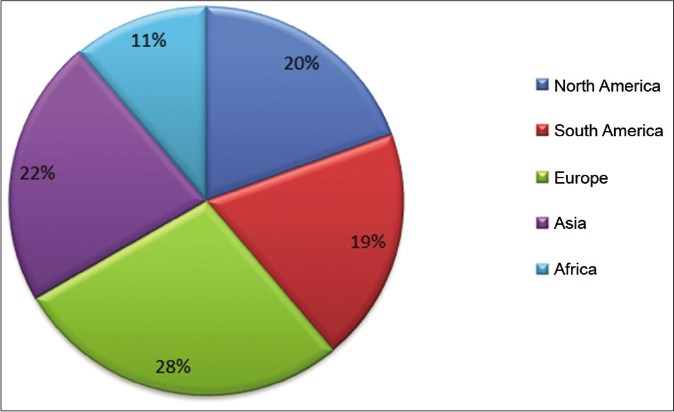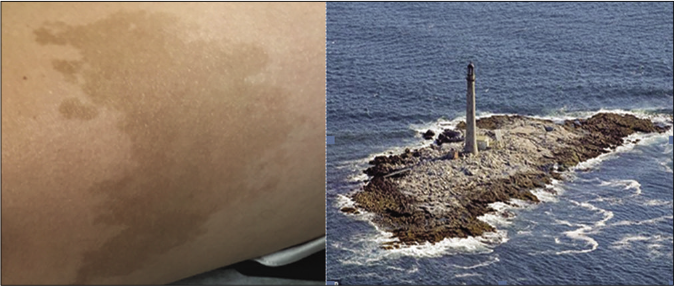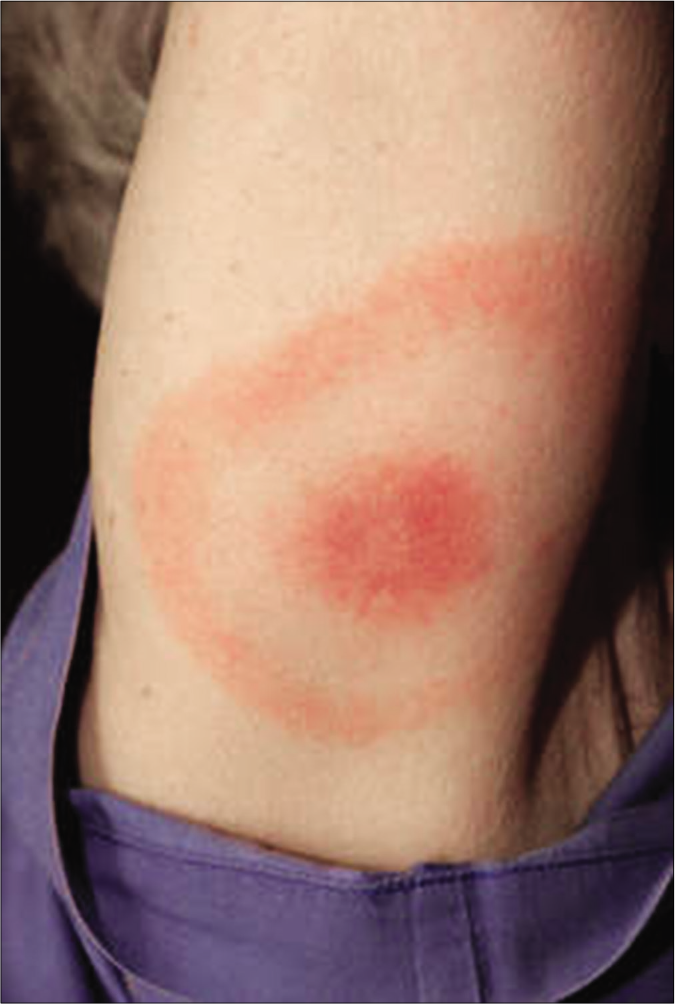Translate this page into:
“TOPONYM” conditions in dermatology
Corresponding author: Dr. Seetharampura Ramamurthy Radhika, #12, Raghav Kuteera, 1st Cross, Srikrupa Layout, Abbigere, Chikkabanavara Post, Bengaluru - 560 090, Karnataka, India. radhikaramamurthy24@gmail.com
-
Received: ,
Accepted: ,
How to cite this article: Radhika SR, Shilpa K, Hongal AA, Revathi TN. “TOPONYM” conditions in dermatology. Indian J Dermatol Venereol Leprol 2022;88:123-7.
Introduction
There are several dermatological conditions named after places. The term eponym originates from the Greek words epi, meaning upon and onia, meaning name. Thus, eponym means giving a name, while toponym is the name derived from a place (geographic eponym) or things.
The advantages of a toponym are its ability to remind us of the lively history of dermatology and acknowledging our gratitude toward the place; additionally remembering the condition becomes easier.1 The main disadvantage is presence of multiple names for the same entity which can often be confusing and ambiguous. All the continents contribute to toponyms [Table 1].
| Continents | North America | South America | Europe | Asia | Africa | Australia |
|---|---|---|---|---|---|---|
| Conditions | Fort Chaffee fever Haverhill fever Lyme disease North American Blastomycosis North Carolina fever Ohio river valley fever Tularemia | Brazilian purpuric fever Coast of Maine Coast of California South American Blastomycosis Pahvant valley fever Rocky Mountain spotted fever San Joaquin valley fever | Acne mallorca Ambras syndrome Familial Mediterranean fever French disease for syphilis Mal de Maleda PPK Norwegian scabies Naxos disease Silk route disease Volhynia fever Ogna type epidermolysis bullosa simplex | Delhi boil Indian tick typhus Indian filing Jaipur block Jodhpur technique Mongolian spots Nagashima PPK Dum Dum fever | Buruli ulcer Calabar swelling Ebola virus disease West Nile fever | Tokelau |
PPK: palmoplantar keratosis
Toponyms
ACNE MALLORCA (GOA ACNE), also called acne aestivalis, is a seasonal recurrent acneiform eruption, considered a type of polymorphic light eruption. Initially reported from Mallorca, the largest island in the Spanish Balearic archipelago. A similar phenomenon has been reported from India—“Goa acne.”2
AMBRAS SYNDROME—The first reported case of Ambras syndrome is that of Petrus Gonzales in 1556, and the name “Ambras” was given as his family portraits were discovered in Ambras Castle during an art collection.3 Ambras syndrome is a rare variant of congenital hypertrichosis lanuginosa, where individuals demonstrate excessive growth of vellus hair, especially on the face, ears and shoulders; occasionally associated with facial and dental abnormalities. Ambras syndrome follows an autosomal dominant mode of inheritance and has been mapped to chromosome 8q.
BURULI ULCER (BAIRNSDALE ULCER) is a chronic debilitating disease caused by Mycobacterium ulcerans, affecting the skin and occasionally bone which can lead to permanent disfigurement and long-term disability. The disease was named after Buruli County in Uganda, because of multiple cases reported from that area in the 1960s.4 Lavender et al. described the disease in detail, based on the observations of Peter MacCallum from the Bairnsdale district, Australia.5 It is also called Daintree ulcer in Queensland.
BRAZILIAN PURPURIC FEVER (BPF) is a febrile hemorrhagic illness caused by Haemophilus aegyptius primarily affecting children. It was first recognized during a 1984 outbreak in Brazil.6
CALABAR SWELLING—Named after the coastal Nigerian town where they were first recorded. It is a type of allergic reaction to the metabolites of the living or dead worms (Loa Loa). 7
COAST OF MAINE café au lait macules (CALMs) are the CALMs seen in McCune-Albright syndrome. They are generally large, seen in the midline, and often have irregular, jagged borders, resembling the coast of Maine [Figure 2].8
COAST OF CALIFORNIA CALMs in neurofibromatosis—They present as well- circumscribed, evenly pigmented macules with smooth borders, resembling the “coast of California” [Figure 3].9
DELHI BOIL in leishmaniasis (Aleppo [Syria] boil, Baghdad [Iraq] boil, Biskra [Algeria] button, Jericho [West Bank] button, Delhi [India] boil, Kandahar [Afghanistan] sore and Lahore [Pakistan] sore) is known by myriad names secondary to the places of origin.10,11
DUMDUM FEVER is a synonym for visceral leishmaniasis; the name is given after William Leishman who worked at Camp DumDum near Calcutta, India.11
EBOLA VIRUS DISEASE—The disease derives its name following two simultaneous outbreaks: one in Nzara and the other in Yambuku, a village near the Ebola River, where it was first identified in 1976.12
FAMILIAL MEDITERRANEAN FEVER—It is the commonest autoinflammatory disease, predominantly affecting the populations of eastern Mediterranean descent—including Sephardic Jews, Mizrahi Jews, Ashkenazi Jews, Arabs, Kurds, Greeks, Turks and Italians. The Mediterranean fever gene (MEFV) is the mutated gene that encodes pyrin, an element of the NLRP3 inflammasome complex.13
FORT CHAFFEE (ARKANSAS) FEVER—Ehrlichia chaffeensis causes human ehrlichiosis.14 It is named after Fort Chaffee Maneuver Training Center— an Army National Guard installation in western Arkansas, where the bacterium was first discovered.
FRENCH DISEASE FOR SYPHILIS—Each affected country blamed the neighboring (and sometimes enemy) countries for their outbreak. Hence, the inhabitants of Italy, Germany and the United Kingdom named syphilis “the French disease,” the French called it “the Neapolitan disease,” the Russians assigned the name “Polish disease,” the Polish called it “the German disease,” The Danish, the Portuguese and the inhabitants of Northern Africa named it “the Spanish/Castilian disease” and the Turks coined the term “Christian disease.”15
HAVER HILL FEVER—A form of rat-bite fever caused by the bacteria—Streptobacillus moniliformis or Haverhillia multiformis. It is also called epidemic arthritic erythema. This was recognized from an outbreak which occurred in Haverhill, Massachusetts in January, 1926.16
INDIAN TICK TYPHUS is a tick-borne rickettsiosis prevalent in India. Rickettsia conori was first isolated from India in 1950 from a brown dog tick, Rhipicephalus sanguineus. The disease is reported primarily from Maharashtra, Tamil Nadu, Karnataka and Kerala.17
INDIAN FILING—this describes a histopathological appearance of neoplastic cells where epithelial cells with atypical nuclei are arranged as single cells (strands) between collagen bundles. These are seen in metastatic carcinomas, in certain leukemias and melanoma.18
JAIPUR BLOCK is used for postherpetic neuralgia which was proposed by Bhargava et al.., It consists of local subcutaneous infiltration of 2% xylocaine, 0.5% bupivacaine and 4 mg/mL dexamethasone solution.19 Neerja Puri proposed a modified Jaipur block for treatment of postherpetic neuralgia with methylprednisolone instead of dexamethasone.20
JODHPUR TECHNIQUE—It is an autologous, noncultured, non-trypsinized, melanocyte and keratinocyte grafting technique used in vitiligo surgeries. The technique was developed and perfected by a group of leading dermatology surgeons from Jodhpur, India.21
LYME DISEASE, caused by the spirochete Borrelia burgdorferi, is named after the epidemic which occurred in the Lyme river valley of Connecticut, America in the 1970s.22 Early symptoms include fever, headache, myalgia and characteristic skin rash—erythema migraines (bulls-eye appearance) [Figure 4].
MAL DE MELEDA PALMOPLANTAR KERATOSIS is a rare autosomal recessive transgradient keratoderma named after the Croatian island of Maleda (Mljet). This keratoderma appears before 3 years of age and is characterized by transgradient keratoderma with sharp demarcation, erythema with associated scleroatrophy, nail changes, pseudoainhum and occasional perioral erythema without any tendency for spontaneous resolution.23
MONGOLIAN SPOT is birthmarks, most commonly located in the sacrococcygeal or lumbar area. They may be single or multiple and usually involve <5% total body surface area.24 A German professor Edwin Baelz described it in Mongolians and named it “Mongolian Flecke” or Mongolian spot, in 188525 However, the name isnon-specific, as the lesions affect other races too.
MOROCCAN LEATHER (a Moroccan town famous for leather) is soft, pliable leather widely used for gloves, shoes, book bindings and wallets. Morocco is a country located in the Maghreb region of North Africa. Moroccan leather/cobblestone/plucked chicken skin appearance is described in pseudoxanthoma elasticum.26
NAGASHIMA PALMOPLANTAR KERATOSIS is an autosomal recessive-inherited palmoplantar keratosis, reported mostly from Japan and China, due SERPINB7 genetic mutation.27 This manifests as nonprogressive keratoderma with mild hyperkeratosis and lacks mutilation, constricting bands, spontaneous amputation and contractures. They may also exhibit perioral erythema, brachydactyly, nail abnormities and lichenoid plaques. The diagnostic clue is the white spongy appearance of the keratosis on exposure to water.
NORWEGIAN SCABIES—This is derived from the description by Danielssen and Boeck in Norway, a type of scabies in which a large number of mites were present in lepers.28 The number of mites may be in millions. It is usually seen in patients with sensory anesthesia, mental impairment, physical incapacity and immunosuppression.
NORTH AMERICAN BLASTOMYCOSIS is also known as Gilchrist’s disease as it was first described by Thomas Casper Gilchrist in 1894. Other names include Chicago disease.29 Blastomycosis is endemic to the Ohio and Mississippi River valleys, the Great Lakes and the St. Lawrence River of North America. Cutaneous lesions may be either verrucous or ulcerative plaques, commonly periorificial in location, contiguous to the respiratory tract.
NORTH CAROLINA FEVER—Leptospirosis or Fort Bragg fever. Fort Bragg is a military installation of the United States Army in North Carolina, leptospirosis was recorded in the soldiers of this fort in 1942. 30
NAXOS DISEASE is an autosomal recessive-inherited palmoplantar keratoderma. The disease was first described in families originating from the Greek island of Naxos.31 It is characterized by arrhythmogenic right ventricular dysplasia/ cardiomyopathy, peculiar woolly hair and diffuse palmoplantar keratoderma.
OHIO RIVER VALLEY FEVER, also known as histoplasmosis, is caused by Histoplasmosis capsulatum. It is endemic to the Midwestern and east-central states in the United States—near the Mississippi and the Ohio River valleys. The humidity and acidity patterns of soil are associated with endemicity.32 Polymorphic skin lesions are characteristic such as, papules, plaques with or without crusts, pustules, nodules, mucosal ulcers, erosions, punched-out ulcers, lesions resembling molluscum contagiosum, acneiform eruptions, erythematous papules and keratotic plaques, purpuric lesions and localized and generalized vegetated forms of dermatitis.
OGNA is a type of epidermolysis bullosa simplex, named after a place in Norway.11 Other genodermatoses named after places are Oudtshoorn (Cape Province of South Africa) keratolytic winter erythema and Rheydt (Germany) ichthyosis hystrix.
PAHVANT VALLEY FEVER is also called tularemia, after a region in western Utah. Tularemia has six characteristic clinical variants: ulceroglandular (the most common type—75%); glandular; oropharyngeal; pneumonic; oculoglandular; and typhoidal.
ROCKY MOUNTAIN SPOTTED FEVER (RMSF) is a tick-borne disease caused by the Rickettsia ricketsii. It was first described in the Rocky Mountain regions of the united states in late 1800.33 Names may change as one crosses borders; as Rocky Mountain spotted fever, becomes São Paulo fever in South America.11
SILK ROUTE DISEASE—also known as Behcet’s disease. It is described among populations around the ancient Silk Road, an erstwhile trading route that stretched from the Iberian Peninsula on the southwestern tip of Europe, across Iran, Iraq and Syria of the Middle-East to the Far East.34 It is characterized by recurrent oral and genital ulcers and uveitis.
SAN JOAQUIN VALLEY FEVER—also known as coccidioidomycosis or desert rheumatism. It is almost exclusively prevalent in the Western Hemisphere.35 The San Joaquin Valley is situated in California, lying to the south of Sacramento–San Joaquin River Delta and is drained by the San Joaquin River. Skin manifestations can present as 1) a part of the acute pulmonary infection representing “acute pulmonary exanthema”; 2) a component of disseminated infection (secondary cutaneous infection), or 3) a primary infection due to direct inoculation (primary cutaneous infection).
SOUTH AMERICAN BLASTOMYCOSIS – Paracoccidioidomycosis is a sub-acute or chronic fungal infection caused by Paracoccidioides brasiliensis and Paracoccidioides lutzii. It is endemic to Central and South America.36
TULAREMIA, caused by Francisella tularensis, is a zoonosis, named after Tulare, California, a small town in San Joaquin valley. Also known as “rabbit fever,” “hunters’ disease,” “deerfly fever,” “tick fever,” “O’Hara’s Disease” and “Francis’ Disease.”37
TOKELAU—Tokelau Islands is a dependent territory of New Zealand. Tinea imbricata or Tokelau caused by Trichophyton concentricum, an anthropophilic dermatophyte is a superficial mycosis. It is endemic in some islands of the South Pacific (Polynesia), South-East Asia, Central and South America and Mexico and hence called Tokelau.38 Also called tinea imbricata; the name is derived from the Latin for “tiled” (imbricata) since the lesions are often lamellar.
VOLHYNIA FEVER—Another name for Trench fever, named after the region of Ruthenia which straddles the border between today’s Poland and Ukraine.11
WEST NILE FEVER—the virus was first isolated from a 37-year-old febrile woman at Omogo in the West Nile District of Uganda in 1937 while conducting research on the yellow fever virus.39

- Contributions from each continent

- Coast of Maine CALMs

- Coast of California CALMs

- Erythema migrans (Lyme’s disease)
Figure 1 and Table 1 represent the contributions from each continent.
Financial support and sponsorship
Nil.
Conflicts of interest
There are no conflicts of interest.
References
- Dermatology: One of the most descriptive fields of medicine. J Pak Assoc Dermatol. 2007;17:71-2.
- [Google Scholar]
- Eponymous names in acne. Nepal J Dermatol Venereol Leprol. 2016;14:59-3.
- [CrossRef] [Google Scholar]
- Ambras syndrome with gingival hyperplasia: A rare entity. Int J Trichol. 2016;8:81-3.
- [CrossRef] [PubMed] [Google Scholar]
- Buruli ulcer: A review of the current knowledge. Curr Trop Med Rep. 2018;5:247-56.
- [CrossRef] [PubMed] [Google Scholar]
- First case of Mycobacterium ulcerans disease (Bairnsdale or Buruliulcer) acquired in New South Wales. Med J Aust. 2007;186:62-3.
- [CrossRef] [PubMed] [Google Scholar]
- Suspected Brazilian purpuric fever, Brazilian amazon region. Emerg Infect Dis. 2009;15:675-6.
- [CrossRef] [PubMed] [Google Scholar]
- Subconjuctival Loa with Calabar swelling. J Korean Med Sci. 2008;23:731-3.
- [CrossRef] [PubMed] [Google Scholar]
- Hyperpigmented patch of the left hemithorax. JAAD Case Rep. 2019;5:280-2.
- [CrossRef] [PubMed] [Google Scholar]
- Appearances in clinical dermatology. Indian J Dermatol Venereol Leprol. 2014;80:432-47.
- [CrossRef] [PubMed] [Google Scholar]
- Leishmaniasis: A disease with many names. JAMA Dermatol. 2014;150:1204.
- [CrossRef] [PubMed] [Google Scholar]
- It's a small and dangerous world: Global dermatologic toponyms. JAMA Dermatol. 2014;150:72.
- [CrossRef] [PubMed] [Google Scholar]
- Diagnosis of Ebola virus disease: Past, present, and future. Clin Microbiol Rev. 2016;29:773.
- [CrossRef] [PubMed] [Google Scholar]
- Familial Mediterranean fever: Current perspectives. J Inflamm Res. 2016;9:13-20.
- [CrossRef] [PubMed] [Google Scholar]
- Human monocytic ehrlichiosis in children. Pediatr Infect Dis J. 2007;26:475-9.
- [CrossRef] [PubMed] [Google Scholar]
- Haverhill fever: Report of a case with review of the literature. Arch Intern Med (Chic). 1939;64:1-14.
- [CrossRef] [Google Scholar]
- Indian tick typhus presenting as Purpura fulminans with review on rickettsial infections. Indian J Dermatol. 2017;62:1-6.
- [CrossRef] [PubMed] [Google Scholar]
- Dermatopathology: An abridged compendium of words. A discussion of them and opinions about them. Part 6 (I-L) Dermatol Pract Concept. 2014;4:1-9.
- [CrossRef] [PubMed] [Google Scholar]
- Jaipur block in postherpetic neuralgia. Int J Dermatol. 1998;37:465-8.
- [CrossRef] [PubMed] [Google Scholar]
- Simplified non-cultured non-trypsinised epidermal cell graft technique followed by psoralen and ultraviolet a light therapy for stable vitiligo. J Cutan Aesthet Surg. 2017;10:81-5.
- [CrossRef] [PubMed] [Google Scholar]
- Mal de Meleda with lip involvement: A report of two cases. Indian J Dermatol. 2012;57:390-3.
- [CrossRef] [PubMed] [Google Scholar]
- The Mongolian spot: A study of ethnic differences and a literature review. Clin Pediatr (Phila). 1981;20:714-9.
- [CrossRef] [PubMed] [Google Scholar]
- Mongolian spots. Indian J Dermatol Venereol Leprol. 2013;79:469-78.
- [CrossRef] [PubMed] [Google Scholar]
- Pebbled skin over axilla and umbilicus. Indian J Paediatr Dermatol. 2019;20:68-70.
- [CrossRef] [Google Scholar]
- Hereditary palmoplantar keratoderma: A practical approach to the diagnosis. Indian Dermatol Online J. 2019;10:365-79.
- [CrossRef] [PubMed] [Google Scholar]
- Norwegian scabies: Rare cause of erythroderma. Indian Dermatol Online J. 2015;6:52-4.
- [CrossRef] [PubMed] [Google Scholar]
- Dirk MEAndrews' Diseases of the Skin: Clinical Dermatology. London: Saunders Elsevier; 2006. p. :319.
- [Google Scholar]
- Leptospirosis in humans. Curr Top Microbiol Immunol. 2015;387:65-97.
- [CrossRef] [PubMed] [Google Scholar]
- Naxos disease: Cardiocutaneous syndrome due to cell adhesion defect. Orphanet J Rare Dis. 2006;1:4.
- [CrossRef] [PubMed] [Google Scholar]
- "Ohio river valley fever" presenting as isolated granulomatous hepatitis: A case report. South Med J. 2009;102:656-8.
- [CrossRef] [PubMed] [Google Scholar]
- Rocky mountain spotted fever: A clinician's dilemma. Arch Intern Med. 2003;163:769-74.
- [CrossRef] [PubMed] [Google Scholar]
- Knitting the threads of silk through time: Behçet's disease-past, present, and future. Int J Rheumatol. 2017;2017:2160610.
- [CrossRef] [PubMed] [Google Scholar]
- Coccidioidomycosis and the skin: A comprehensive review. An Bras Dermatol. 2015;90:610-21.
- [CrossRef] [PubMed] [Google Scholar]
- Paracoccidioidomycosis: Epidemiological, clinical, diagnostic and treatment up-dating. An Bras Dermatol. 2013;88:700-11.
- [CrossRef] [PubMed] [Google Scholar]
- A neurotropic virus isolated from the blood of a native of Uganda. Am J Trop Med. 1940;20:471-92.
- [CrossRef] [Google Scholar]





